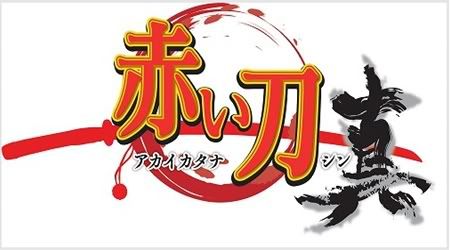
Game: Akai Katana Shin 赤い刀・真
Developer: Cave
Publisher: Cave
Release Date: May 26, 2011
Genre: Shooter
System: XBOX 360 (Region locked)
When I first saw game play footage of Akai Katana the first thing it reminded me of was Progear. Things like its art direction (chubbified enemy vehicles a la Metal Slug) and use of vintage aircraft, it's clear this game is for the Progear fans. I am sure every shooter fan out there thought the same thing. Once I played the game for the first time it was apparent that this game was only similar to Progear in its appearance, but not its game play. Game play elements are a mix of Espgaluda and elements unique to Akai Katana. If you didn't like Progear or the Espgaluda series, don't let these similarities deter you from trying this game. I guarantee you, it's a whole new experience.
Akai Katana is set in a fictional era in Japanese history which closely resembles the 1960s. This era is called "Taishou" (the 1960s were a part of the "Showa" era in reality). In this era of rapid economic growth after the great war a new natural resource called "Kidouseki" was discovered. This can be very loosely translated as "Prayer Guide Stone" This resource can be used to power everything. It was also usedo make special 'swords' called "Kidoutou" which only a few people who hold a special seal can wield. These select warriors have the power to manipulate the sword's powers. This sword, which drains the life of those who hold it, transforms into a "Kesshoutou" or "Akai Katana" (Red Sword). Once the Kidoutou transforms into the sinister Akai Katana it needs the flesh and body of its wielder to show its power.
Of course with precious resources comes conflict. There is an unnamed empire among greater nations. Despite being a small country they must supersede other countries for the sake of their protection (they may want to steal the precious Kidouseki). They chose war to carry out this objective. The leader, whose name is Basho, formed an army within his empire to advance over neighboring countries to show its great power. This group, called the "Jikkan Juninshu" (loosely translated as "The Ten Celestials), were greatly admired. For the sake of protecting their own country, The Ten Celestials were bestowed with a special privilege: to kill people with impunity for the sake of strengthening their own country. Meanwhile because of the aggressive authoritarian acts against neighboring countries, a few of the Ten Celestials found it disagreeable and so the group split into two factions. A civil war was declared by the rebels and among the ranks of the rebellion force is the emperor's son and daughter.
The trump card of the rebel forces are three fighter aircraft called the "Shake Volts". The Shake Volts possess a special power: they can increase their firepower through sacrificing (your own) life. This is aided by the sword and the Prayer Guide Stones. Kikyou, the emperor's son, and his allies wield the same power as their enemies: the Akai Katana. They swear to transform its menacing power into a victory over evil. Thus the anti-imperial rebel force, dubbed "Gekka", was formed to bring out justice for the world.
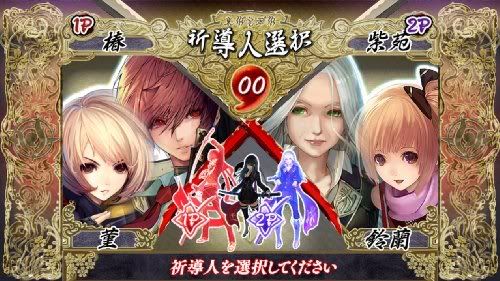
The Shake Volt fighters' designs are based on actual World War II aircraft. Although they have an odd English name in the game (they are never referred to in Japanese), the strange thing is when you write "Shake Volt" in Japanese it becomes "Shinden", and Shindens were Japanese prototype fighter aircraft in World War II. In fact, one of the selectable aircraft is modeled after the Kyushu J7W aka "Shinden". Somebody at Cave was having a little fun...or I could be completely wrong. Nonetheless it's either a cool coincidence or a cheeky parody. The other two aircraft are a Lockheed P-38 Lightning and a Nakajima (present day Subaru) A6M2N Rufe. In the game the aircraft individually are not called by their real world names. The J7W Rufe is called the Kinsenka or (Marigold), the P-38 Lightning is called the "Yaezakura" (Double Cherry Tree), and the A6M2 Rufe is called the Kochouran (Butterfly Orchid).
If you are familiar with Cave shooters than getting used to the shooting system is a piece of cake. Like almost all Cave shooters you have a regular rapid fire shot, a concentrated beam (when the 'shot' button is held down), and a bomb attack. Another command is the "henshin" mode where your plane becomes a flying ninja. More on this later. Your ship is followed by a pod or 'option' in shooter talk. This pod fires bullets and lasers depending on your chosen attack. This pod can be multiplied by powering up. You will always have a least one no matter how many times you die. The ship itself is fairly straightforward, it's the Ninja Mode that adds a little spice to an established formula.
The character design in this game is very stylish. Run-of-the-mill anime characters dressed in Harajuku fashion with a little bit of Akihabara Moe (read: zettai ryouiki) thrown in for good measure (or fan service). Typical of Japanese games and anime, the characters are too good-looking and too young to be in the roles they are in. The main characters are a teenage brother and sister team, Kyouki and Botan Saionji who lead the rebel forces. They are the children of the emperor for whom they are fighting against. They don't believe in their father's imperialistic ways and plus they are a bit angry that their father killed their mother. That would do it. They are joined by an all-female rebel group who have their own agendas. If you think you see two male characters, look again. Tsubaki is really a woman dressed as a man. Each character has their own style of attack and personalities. Depending on your style of playing, some characters will seem more efficient than others. No one character is stronger than the other so it is all a matter of preference. You choose characters in twos as one pilots the ship and the other is the "Ninja".
The bosses are equally as stylish and just like the shake volts, all the bosses are named after plant life. The bosses are flying humans much like your ship when you are in Ninja Mode. Facing all human bosses would be fairly boring so it's great that the second half of boss fights become more exciting by World War II era battleships, bombers, aircraft carriers, etc being summoned and manipulated to defy all laws of gravity all with the purpose of destroying you.

Like Espgaluda you can transform into a more powerful character temporarily. Depending on the version you play, they are not only more powerful but invincible. This is referred to as "Ninja Mode". Orbs are collected and accumulate in a meter which then slowly drains as you are in Ninja Mode. An interesting aspect of this is that the meter is shared with your life bar. So the less life (and lives) you have, the longer you can be in Ninja Mode. Players who use suicide as a strategy (like in Battle Garegga and Ibara, among others) would find this feature very comfortable, while others may find it more challenging. I am part of the latter.
In the home port of Akai Katana there are three versions of the game. These include Akai Katana, Akai Katana Shin, and Zetsu Akai Katana. Akai Katana is just a straight port of the arcade version, and Zetsu is the arcade version with some improvements and changes. These improvements include things like 16:9 widescreen support (arcade is 4:3), the extra level from Shin is included, among other things. Changes include modified speeds of the ships under certain conditions, power increase of concentrated laser beams, and many others. The "Shin" version is almost a whole new game as far as strategies and scoring is concerned.
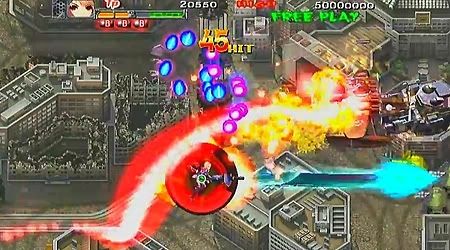
The biggest difference in the "Shin" version is your firepower when you are in Ninja Mode. It works something like this: while you are in plane mode dodge enemy bullets as closely as possible to accumulate katana orbs within your force field. When the situation calls for it, transform into Ninja Mode so that the katana orbs transform into katanas which appear behind your character. Transform back into normal (plane) mode and watch your katanas unleash hell upon your enemies in a beautiful shower of blood and cherry blossom petals. It may sound intimidating but once you play the game and get the hang of this system it works wonders. If you care about scores, you are awarded massive amounts of points for executing the katana attack.
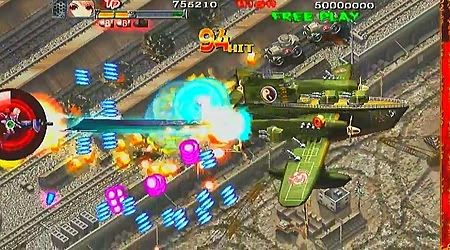
While opinions may differ on which version of the game is best, I am going to choose Shin as the winner. I see why Zetsu would please some people who prefer a more raw shoot-em-up experience, but the annihilating enemies with your katanas is just all too exhilarating. The pink cherry blossom petals exploding when your katanas thrust forward as you are awarded with gold coins which come raining down in a golden shower is most satisfying. No puns intended, of course.
The difficulty of this game is, in my opinion, easier among Cave shooters. Don't get me wrong, this game is no walk in the park, but compared to other bullet hell shooters like Daifukkatsu and Ketsui, this one seems a bit tame. Just a bit. There are training and novice modes available to you if the main game is a bit too much to handle. You can also have a friend help you in the carnage, but be advised that Shin and Zetsu modes do not support 2-player simultaneous play. Bummer.

As always with Cave games the graphics are vivid and crisp. The detail of even the weakest enemy shows the designers weren't cutting corners. The underwater stage is very reminiscent of "In The Hunt". When it comes to the game's aesthetic, it is very Japanese. Sure, Deathsmiles has lolicon characters and Daifukkatsu has giant mech school girls, but that is not the "Japanese" I mean. The stages are all set in Japan with Japanese landmarks in the backgrounds. From Tokyo Tower to Kyoto's ever-recognizable Okita and Mandara mountains. You are taken along a quick tour of Japan while destroying everything in your path. The last Cave game to do this was Guwange.That is a shame because I would love to see more shooters with this aesthetic.
Included with the game is a DLC code for extra voice sequences. These voice sequences just add more depth to the game (given you understand Japanese) as you progress through a level. It's a nice little touch. While it's not as entertaining or lengthy as the commentary you get in Oshaberi Parodius, it's still a nice addition to the drama of the game. If you don't want to hear overacted interjections while you play, you can turn off the voice acting in the options menu. The voice acting is the typical anime overacting some of you have grown accustomed to. Cave didn't skimp on the voice actors as they have hired veterans in the field who have worked on games such as Persona, Last Remnant, Metal Gear Solid series, etc and worked on anime such as Captain Tsubasa, Doraemon, Gundam, plus many others. The voice actors also lent their voices to the Japanese dubs of American products such as Ugly Betty, 24, Lost, ER, plus many many others. Useless trivia: the voice actor of the first stage boss, Kenyu Horiuchi, is the go-to Japanese dub voice actor for all of Brad Pitt's roles.
Lastly I want to mention that the leaderboards are a great tool to learn how to master this game. With available replays allows players to see how others achieve their high scores. There is a lot to be learned from watching players better than you, so it's worth your while to watch a few replays uploaded by the pros.
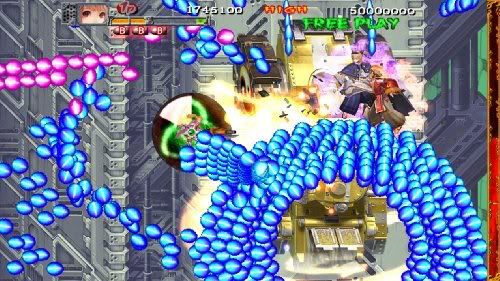
Praises:
The game is well-balanced with plenty of avenues to create your strategies. The game play is deep and rewarding. The difficulty is not as savage as other Cave shooters which makes this game great for novice players or those who want to get their feet wet with a bullet hell shooter. It's also not too simple so more seasoned players won't be turned off.
Great replay value. While shooters are not known for their replay value, this game has three different versions on one disc. Another reason why this is praiseworthy is that they are all on the disc without having to download anything. In this day and age of game companies selling add-ons, this game comes almost complete. Even previous Cave shooters required (free) DLC to add to the experience but this game comes with it all. As mentioned earlier, the only DLC is the free voice pack which adds no game play changes to the game. It's sad that this is a praise, but these are the times we are in.
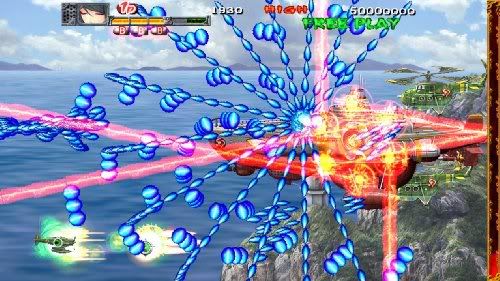
Grievances:
While the boss battles are extravagant and lengthy they seem to go on for too long at times and it also seems Cave dropped the ball on most the boss bullet patterns. Perhaps I expect too much from Cave bosses, but the boss battles could have been more challenging. Only the last boss provides a great example of classic Cave bullet patterns.
Another gripe is that there are no warning signs of enemies coming in at irregular angles. The Deathsmiles games had these, so why not this one? How can I dodge something that I can't see coming? Perhaps that is part of the challenge. My last complaint is a very minor one but I am sure I share with all shooter fanatics. There is no initial entry after finishing your game. Your high score is saved but the game still lacks that little detail what adds to the arcade feel of any game, entering your initials. The closest thing you can get to that is your XBL gamertag is published onto the leaderboards.
The Verdict:
This game is definitely Cave's best horizontal shooter and their most stylish. From the old fashioned Japanese motif mixed with modern style, this game exudes many aspects of Japanese design. The satisfying feeling you get when you annihilate all of the enemies on the screen in one fell swoop of your piercing katanas never gets old. Arcade and Zetsu modes are great, but the Shin mode is what really makes this game almost perfect.
No backups, pirates, or emulation. My copy:
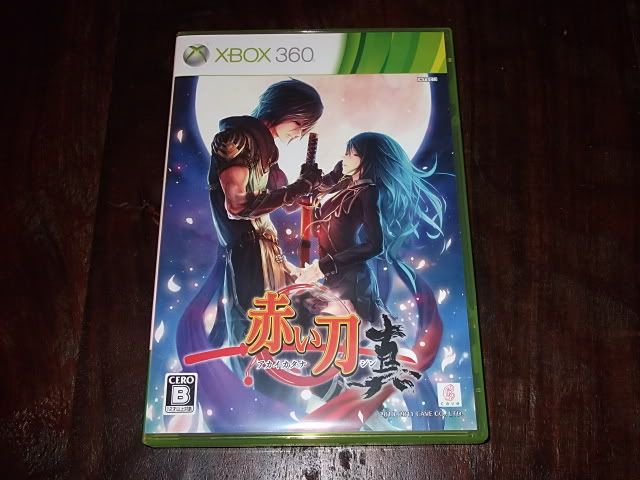

No comments:
Post a Comment